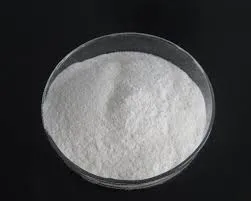
พ.ย. . 19, 2024 21:51 Back to list
Exploring the Applications and Benefits of Hydroxy Methyl Cellulose in Various Industries
The Versatility of Hydroxy Methyl Cellulose Applications and Benefits
Hydroxy Methyl Cellulose (HMC), a modified cellulose derivative, has gained significant attention in various industries due to its unique properties and versatility. Derived from natural cellulose through a series of chemical processes, HMC is a white, odorless powder that is soluble in cold water, resulting in a clear, viscous solution. Its distinct characteristics, such as thickening, emulsifying, and film-forming capabilities, make it an essential ingredient in multiple applications ranging from pharmaceuticals to food, cosmetics, and construction.
1. Properties of Hydroxy Methyl Cellulose
The unique properties of HMC stem from its chemical structure. By replacing a portion of the hydroxyl groups on the cellulose molecule with methyl groups, HMC exhibits enhanced solubility in water and improved rheological properties. This modification allows HMC to form stable gels and viscous solutions, which are crucial in many industrial applications. HMC is non-toxic, biodegradable, and does not provoke allergic reactions, making it a safer alternative to synthetic additives in products.
2. Applications in the Pharmaceutical Industry
In the pharmaceutical sector, HMC is widely utilized as a thickening agent, binder, and controlled-release agent in drug formulations. Its ability to regulate the viscosity of liquid formulations ensures accurate dosing and improves the stability of dispersed systems. Moreover, HMC is often used in the development of tablet coatings and as a film former in capsules. Its controlled release properties allow for extended drug action, enhancing therapeutic efficacy while minimizing side effects.
Furthermore, HMC plays a significant role in ophthalmology. In eye drops and lubricating solutions, it acts as a viscoelastic agent, providing relief for dry eyes by maintaining moisture on the eye surface. This property is particularly valuable considering the increasing prevalence of dry eye syndrome due to environmental factors and increased screen time.
In the food industry, HMC is recognized for its multifunctional properties. It serves as a thickener, stabilizer, and emulsifier in a wide range of food products, including sauces, dressings, and dairy items. HMC enhances the sensory attributes of food, providing desirable texture and mouthfeel. Its water-binding capacity helps retain moisture, contributing to the shelf-life of products, and preventing undesirable separation.
hydroxy methyl cellulose

Additionally, HMC is used in gluten-free baking as a replacement for wheat flour. It provides the necessary structure and elasticity that gluten typically offers, allowing gluten-intolerant individuals to enjoy baked goods without sacrificing taste or texture. The increasing demand for gluten-free products has amplified the application of HMC in the food sector.
4. Cosmetic and Personal Care Products
The cosmetic industry benefits greatly from the properties of HMC, where it is employed as a thickening agent in creams, lotions, and gels. Its ability to form stable emulsions makes it an ideal ingredient for personal care products, aiding in the consistent performance of formulations. HMC provides a smooth, silky feel on the skin, enhancing product application.
Moreover, HMC is used in haircare products and styling gels due to its film-forming capabilities, which help maintain hairstyles and provide hold without stiffness. Its non-toxic nature ensures it is safe for use in cosmetics, aligning with the growing consumer preference for natural and clean-label products.
5. Construction Applications
The construction sector has also found valuable applications for HMC. It is widely used in cement-based products, such as mortars and grouts, where it enhances workability and provides water retention. HMC improves the adhesion of particles, resulting in stronger and more durable constructions. Its ability to reduce the water-cement ratio in mixtures contributes to more sustainable building practices by minimizing water usage while maintaining material performance.
Conclusion
Hydroxy Methyl Cellulose stands as a testament to the versatility and functionality of natural cellulose derivatives. Its applications across various industries highlight its significance as a multifunctional additive. With ongoing research and innovation, the demand for HMC is expected to grow, driven by the quest for sustainable, effective, and safe ingredients. Its ability to meet modern consumer needs while providing performance benefits ensures that HMC will remain a vital component in the formulation of countless products. As industries evolve, HMC’s role will likely expand, further cementing its place in our daily lives.
-
Versatile Hpmc Uses in Different Industries
NewsJun.19,2025
-
Redispersible Powder's Role in Enhancing Durability of Construction Products
NewsJun.19,2025
-
Hydroxyethyl Cellulose Applications Driving Green Industrial Processes
NewsJun.19,2025
-
Exploring Different Redispersible Polymer Powder
NewsJun.19,2025
-
Choosing the Right Mortar Bonding Agent
NewsJun.19,2025
-
Applications and Significance of China Hpmc in Modern Industries
NewsJun.19,2025







